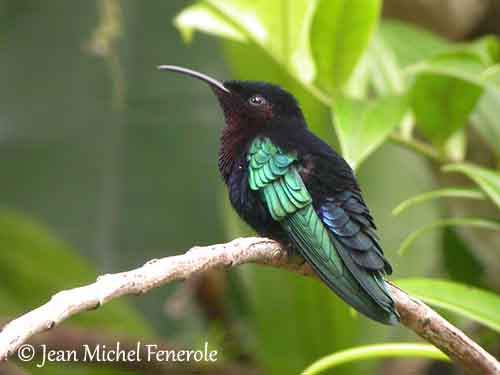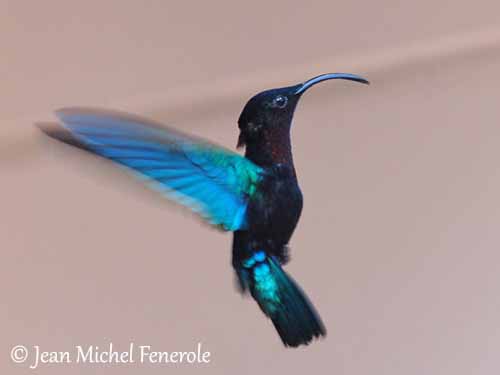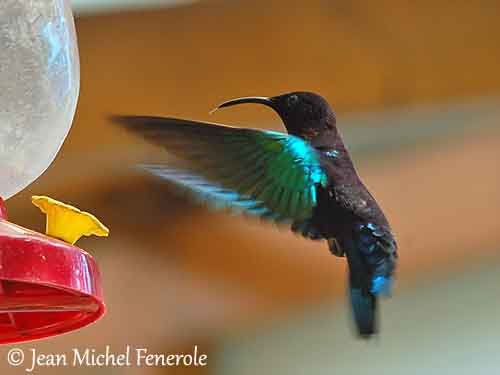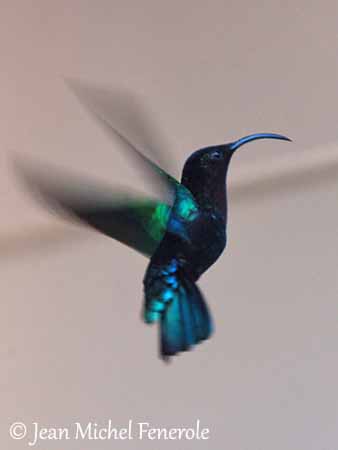
Fr: Colibri madère
All: Purpurkehlkolibri
Esp: Colibrí Caribeño Gorgimorado
Ita: Colibrì dei Caraibi golapurpurea
Nd: Granaatkolibrie
Sd: Purpurstrupig karib
Photographer:
Jean Michel Fenerole
Photos d’Oiseaux du monde
Text by Nicole Bouglouan
Sources:
HANDBOOK OF THE BIRDS OF THE WORLD Vol 5 by Josep del Hoyo-Andrew Elliott-Jordi Sargatal - Lynx Edicions - ISBN: 8487334253
BirdLife International (BirdLife International)
The Wilson Journal of Ornithology
BirdsCaribbean - Society for the Conservation and Study of Caribbean Birds (SCSCB)
Purple-throated Carib
Eulampis jugularis
Apodiformes Order – Trochilidae Family
INTRODUCTION:
The Purple-throated Carib is found in several islands of the Lesser Antilles, and this species is endemic to this area.
Male and female show sexual dimorphism with the male larger than the female, and female’s bill longer and more curved than male’s bill. This is an adaptation to their different feeding behaviour.
DESCRIPTION OF THE BIRD:
Biometrics:
Length: 11-12 cm
Weight: M: 9-12 g – F: 7-10 g
The adult has dark plumage, mostly black, with iridescent emerald to golden green wings and tail. The rump is bluish. The uppertail-coverts are metallic greenish-blue.
On the underparts, chin, throat and breast are iridescent purplish-red.
The head is black but the malar area joins the chin, both being purplish-red.
The long, downcurved bill is black. The eyes are dark brown. Legs and feet are blackish.
The female has similar plumage but her bill is longer and more sharply downcurved. She is smaller than male.
The immature has orange throat and breast with red speckles, and scattered brown feathers on the upperparts. The bill is shorter.

RANGE:
The Purple-throated Carib is found on most islands of the Lesser Antilles.
HABITAT:
The Purple-throated Carib frequents forested areas and plantations, but also semi-open areas according to food availability. It can be seen at forest edges and tree tops in primary and secondary forests, from almost sea-level up to 800/1200 metres of elevation.
CALLS AND SONGS: SOUNDS BY XENO-CANTO
The Purple-throated Carib gives sharp “chewp” repeated rapidly when the bird is excited.
BEHAVIOUR IN THE WILD:
The Purple-throated Carib feeds on nectar from flowers and also at feeders when available. It also takes insects and catches them like a flycatcher, which is unusual for hummingbirds. It may hawk for insects on the wing, and gleans invertebrates from foliage and spider webs.
Male and female have different feeding behaviour. The female usually takes nectar from flowers with long, curved corolla, whereas the male feeds mainly from another Heliconia species with shorter and straighter corolla.
The feeding strategy of each sex differs too. The male defends its favourite flower species from intruders and also from the female. The female does not defend her feeding area.

The Purple-throated Carib performs threat displays in front of an intruder, with horizontal body and wings held slightly down, perpendicular to the body. The bill is pointed towards the opponent and shakes while the head is moving side to side. This posture symbolizes the flight, but the amount of energy is less important for the bird. But flying chases are reported too.
The Purple-throated Carib is resident in its range with some altitudinal movements.
The flight is that of all hummingbirds, with rapid 8-shaped wingbeats when feeding, allowing the bird to move in all direction, including backwards.

REPRODUCTION OF THIS SPECIES:
The breeding season occurs between February and May, and occasionally between January and September.
The Purple-throated Carib builds a cup-shaped nest, about 3-5 metres above the ground, sometimes higher, on vertical branch in tree. It is made with plant fibres and spider webs. The outer part can be camouflaged with pieces of bark, moss or lichen. The female adds nest materials until the end of the incubation.
She lays 2 white eggs and incubates during 17-19 days. At hatching, the chicks are dark, with two rows of down on the back. They fledge 17-20 days after hatching, but they remain with the female for two or three weeks more. They are fed on insects and nectar.
The female is very territorial and defends the nest and the young. She may attack larger species within an area of ten metres around the nest.
PROTECTION / THREATS / STATUS:
The Purple-throated Carib has restricted range, but it is common in forests and plantations at higher elevation.
It is threatened by clearance of forest and changes in farming intensity.
But currently, this species is not globally threatened.
